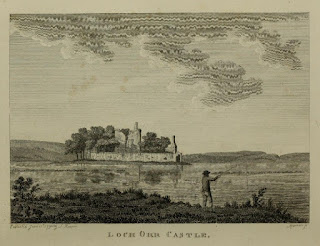Needing
somewhere new to explore, I headed off to the deepest, darkest depths of Fife,
where I visited a castle so ruined that it is barely more than some tall toothy
stumps of walls jutting out of the ground.
Not to disparage this castle, as I think that out of all the various
castles I’ve visited in my lifetime, my favourites have all been the ones
crumbling into rubble.
After
taking a train to Lochgelly, I walked down to Lochore Meadows Country Park
where, near to the entrance, Lochore Castle stands. The park, now a tranquil place of lochside
walks, trees, and bird song, was once a hive of industry with a colliery, a
railway and all the heavy industry associated with coal mining. All of that is now long gone, with only the
winding tower of the mine standing as a monument to its industrial past.
Lochore
Castle originally stood on the intriguingly named island of Inchgall, the
Island of Strangers, on Loch Ore. While
the castle still stands where it always stood, the island it stood on is an
island no more, after the loch around it was drained in the 1790s. Confusingly, the loch is now back, though not
quite in the same place it used to be.
Get your head around that one.
On
arriving at the castle, I wandered around and through what remained of it. The
whole middle section of the main tower has now gone, leaving only some of the
thick outer walls. Sitting on the top of
these were the brittle and dead remains of plants from last summer. Once green and bright with flowers reaching
up to the warmth of the sun, they were now brown stems and seed husks that
swayed lifelessly in the gentle afternoon breeze. As I walked out and round the
outer walls my feet crunched through the strimmed remains of dead bramble bushes,
and I had to shield my eyes from the low, bright, and blinding winter sun. Jutting out from one of the walls was a tree
stump. In the dead wood and twisted
knots, I found what looked to me like a surprised face peering from the distant
past out onto our ‘modern’ world. I
waved hello and walked on by.
It
is believed that there was a castle on this site from around the Twelfth Century,
this having probably been built for Robert the Burgundian. He appears to have been a French knight who
was granted the lands around Loch Ore, and an excavation at the castle in 2015
found pieces of Medieval French pottery.
Robert’s family then appear to have taken on the Lochore name and in 1291
the castle and lands around were owned by Constantine de Lochore. Constantine was the Sheriff of Fife, and a
man of changing loyalties. He originally
swore allegiance to the English king, Edward I, but then changed his mind and joined
William Wallace to fight in the war for Scottish Independence. After being captured and held prisoner for a
time, he again swore allegiance to Edward and was allowed to return back to
Fife.
In
the Fifteenth Century the castle passed into the hands of the Wardlaws of Torry,
and much of it was rebuilt for Robert Wardlaw.
The castle was described at that time as being a ‘strong square tower,
with many lower buildings, surrounded by a wall, with round towers’ and that it
was ‘washed by the waters of the Loch, which abound with pike and perch.’ It
was also said to be one of the strongest castles in Fife.
At
some point in the Eighteenth Century the castle was abandoned, and it fell into
ruin. In 1938 there were calls for the
remains to be demolished, as they were seen by some to be dangerous due to
subsidence in the area caused by mining.
The local council found that they did not have the powers to order the
demolition, and luckily the owner of the land was unwilling to do so. The castle ruins are now seen as being of
special interest, given that it was probably one of the earliest castles built in
Fife.
After
my wander around the ruins, I left the Skulferatu that had accompanied me in a
gap in the crumbling cement of the walls.
The
coordinates for the location of the Skulferatu are -
I
used the following sources for information on Lochore Castle –


















No comments:
Post a Comment